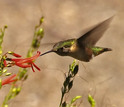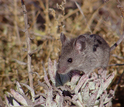News Release 16-111
NSF awards $15.9 million to foster new understanding of biological systems on regional to continental scales
Macrosystems biology and early NEON science awards support predictive understanding of large-scale biological responses to climate, land-use change

NSF MacroSystems Biology and Early NEON Science researchers are studying tree genes to canopies.
September 22, 2016
This material is available primarily for archival purposes. Telephone numbers or other contact information may be out of date; please see current contact information at media contacts.
Have you looked closely at a stream, lake or woodland and observed changes in it over time? That's exactly what scientists are trying to do on a larger, regional-to-continental scale -- a macrosystems biology scale.
Macrosystems biology might be called biological sciences writ large. To better detect, understand and predict the effects of climate and land-use changes on organisms and ecosystems at these large scales, the National Science Foundation (NSF) Directorate for Biological Sciences has awarded $15.9 million for 12 new MacroSystems Biology and Early NEON (National Ecological Observatory Network) Science projects.
Early NEON Science grants go to projects that don't otherwise fit into the macrosystems biology focus on regional- to continental-scale questions, but use or leverage NEON data and/or NEON samples and specimens to address innovative ecological or other biological questions, or develop analytic or computational tools that enhance the use and value of NEON data.
How will the biosphere respond to natural and human-induced changes across a range of time and space scales? What is the pace and pattern of these responses? What are the effects on ecosystem services -- such as the availability of freshwater -- across regions and continents?
"Our current understanding of the biosphere is largely based on knowledge derived from small plot research or from satellite-scale remote sensing," says James Olds, NSF assistant director for Biological Sciences. "But the basic scientific knowledge needed to predict the consequences of climate and land-use change, or invasive species effects on living systems, is difficult to obtain from studies conducted at local or global scales. We need to look at them at the regional-to-continental scale."
That's where NSF's MacroSystems Biology and Early NEON Science awards come in, says Olds. "They allow us to study issues that have become critical to the future of our planet in ways that will foster a new understanding of, for example, the ecology of major cities and the water quality of lakes in the continental U.S."
A significant part of these new approaches involves the integration of biology with other fields, including the geosciences, engineering, mathematical and physical sciences, and social, economic and behavioral sciences.
How are regional-scale processes in plant and animal invasions, and in disease transmission, shaped by continent-wide environmental and land-use patterns? How can continent-wide data lead to better forecasts of disease outbreaks? How do invasive species and infectious diseases arrive at new locations, sometimes across great distances?
MacroSystems Biology and Early NEON Science investigators are seeking answers.
Among the topics awardees will address are: forest function from genes to canopies; how local and migratory foraging affects networks of plants, pollinators and pathogens; alternative ecological futures for the "American Residential Macrosystem" (our homes and lawns) in six study cities from Boston to Los Angeles; and "mice-o-scapes": understanding the effects of climate and landscape change on small mammal ecology over the past 100 years.
The projects crisscross regions and continents, and bring together scientists from biological sciences, geosciences and other fields in an effort to find out what makes Earth's biosphere tick.
2016 MacroSystems Biology and Early NEON Science Projects
Jennifer Cotton, California State University, Northridge: RUI/Collaborative Research: MSB-ECA: Mice-o-scapes: Using isotopes to understand the effect of climate and landscape change on small mammal ecology over the past 100 years
Michael Dietze, Boston University: Collaborative Proposal: MSB-ENSA: The Near-term Ecological Forecasting Initiative
Songlin Fei, Purdue University: MSB-FRA Modeling Invasion Dynamics Across Scales (MIDAS)
Peter Groffman, City University of New York-Advance Science Research Center: Collaborative Research: MSB-FRA: Alternative ecological futures for the American Residential Macrosystem
Catherine Hulshof, University of Puerto Rico, Mayaguez: MSB-ECA: Climate change and plants on unusual soils: Detecting and modeling ecosystem response of Caribbean serpentine floras
Jaclyn Matthes, Wellesley College: MSB-ECA: A generalized framework for modeling the impacts of forest insects and pathogens in the Earth System
Scott Ollinger, University of New Hampshire: MSB-FRA: The influence of biological diversity on land-atmosphere exchange in forests: confronting theory with data
Kevin Rose, Rensselaer Polytechnic Institute: MSB-ECA: Assessing the effects of cross-scale scale interactions mediating sub-continental lake thermal trends and carbon cycling
Patricia Soranno, Michigan State University: Collaborative Proposal: MSB-FRA: A macrosystems ecology framework for continental-scale prediction and understanding of lakes
Nathan Swenson, University of Maryland: Collaborative Proposal: MSB-ENSA: Forest function from genes to canopies: disentangling the fine scale spatio-temporal variation in gene expression and tree growth
Phillip Townsend, University of Wisconsin-Madison: MSB-ENSA: Foliar traits and ecosystem variability across NEON domains
Erin Wilson-Rankin, University of California-Riverside: MSB-ECA: Local and Migratory Spatial Foraging Affects Plant-Pollinator-Pathogen Networks
-NSF-
-
Pollinators and plants are the subject of a new MacroSystems Biology/Early NEON Science grant.
Credit and Larger Version -
Ecological variables and tick-borne diseases are among the new grant topics.
Credit and Larger Version -
MacroSystems Biology and Early NEON Science investigators are tracking plants' flowering timing.
Credit and Larger Version -
Mice-o-scapes--understanding small mammal ecology over the past 100 years--is another new project.
Credit and Larger Version -
Aerial views of lawns in San Diego, Miami, Philadelphia, Chicago, Phoenix, and Levittown, N.Y.
Credit and Larger Version
Media Contacts
Cheryl Dybas, NSF, (703) 292-7734, email: cdybas@nsf.gov
The U.S. National Science Foundation propels the nation forward by advancing fundamental research in all fields of science and engineering. NSF supports research and people by providing facilities, instruments and funding to support their ingenuity and sustain the U.S. as a global leader in research and innovation. With a fiscal year 2023 budget of $9.5 billion, NSF funds reach all 50 states through grants to nearly 2,000 colleges, universities and institutions. Each year, NSF receives more than 40,000 competitive proposals and makes about 11,000 new awards. Those awards include support for cooperative research with industry, Arctic and Antarctic research and operations, and U.S. participation in international scientific efforts.
Connect with us online
NSF website: nsf.gov
NSF News: nsf.gov/news
For News Media: nsf.gov/news/newsroom
Statistics: nsf.gov/statistics/
Awards database: nsf.gov/awardsearch/
Follow us on social
Twitter: twitter.com/NSF
Facebook: facebook.com/US.NSF
Instagram: instagram.com/nsfgov





